- Home
- Blanket Stitch
A Beginner's Guide to the Ever-Useful Blanket Stitch
Versatile and decorative, the blanket stitch has a rich history but is still popular today in both freestyle and counted embroidery techniques.
Its true beauty lies in how many ways you can use it, from creating neat edges on a project to adding creative flair with textured fillings.
For example, I used this one simple stitch to outline and shade flowers, build a freehand hermit crab shell, and form the delicate bridges in a cutwork design.
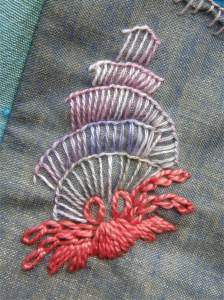
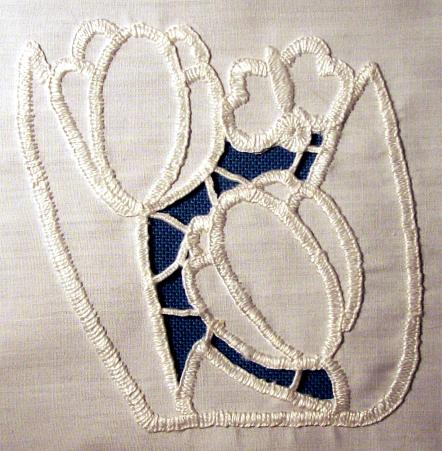
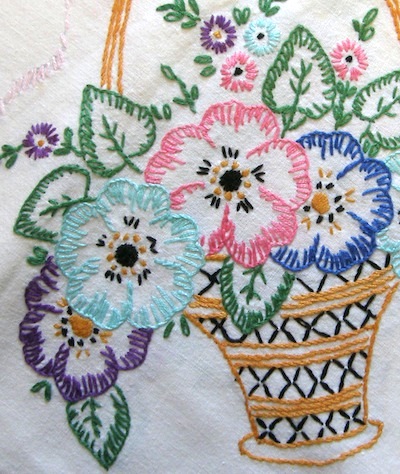
The best part is that this wonderfully effective stitch is surprisingly simple to learn.
This guide will walk you through the easiest method for a beginner to get a beautiful, even result every time.
How to Do Blanket Stitch: The Stab Stitch Method
While you can work this stitch "in the hand," I find that for beginners, using an embroidery hoop is the best way to go. A hoop keeps your fabric taut, which makes it much easier to keep your stitch tension even and avoid puckering the fabric.
A Few Quick Tips Before You Start:
Thread Choice: The type of thread you choose can make a big difference. A non-stranded thread like Perle cotton is a great choice. I used Perle cotton number 8 for this sample.
Keeping Stitches Even: A great trick while you're learning is to mark evenly spaced dots on your fabric with a disappearing ink pen to guide your stitches.
Learning the Stitch: Watch the Video
The easiest way to learn is to see the stitch in action! This short video shows you exactly how to work the blanket stitch using the "stab stitch" method in a hoop.
You can follow along by clicking the transcript button, below.
Step-by-Step Instructions:
When your fabric is stretched in a hoop, you'll work with one hand above and one below the fabric. Start from the left and work towards the right
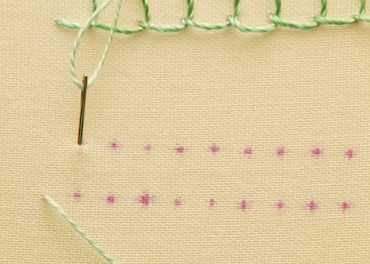
Bring your needle up from the back at your starting position on the bottom line.
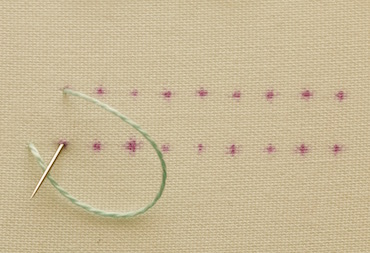
Take the needle down through the fabric at the top of your stitch, but don't pull the thread all the way through. Leave a loose loop of thread on the surface of your work.
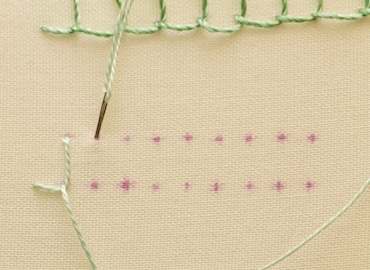
Bring your needle back up to the front at the next dot along the bottom row, making sure your needle comes up inside the loop of thread you just made.
Gently pull the thread through until the loop tightens and sits neatly along the bottom line. Don't pull it too tight.
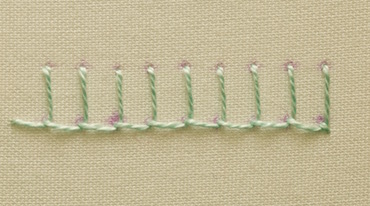
Continue this motion until you reach the end of your row. To finish, make a tiny "tie down" stitch just outside the last loop to secure it in place.
Your Turn to Practice!
Now that you have the basic rhythm down, it's time to play with spacing. Grab a scrap piece of fabric and experiment.
The distance you leave between each stitch is up to you, and it can dramatically change the look of your work.
Try stitching one row with the stitches spread out to create an open, airy edge.
Right below it, try another row with the stitches packed tightly together for a dense, solid line.
There are no hard and fast rules, so have fun seeing what you prefer!
Ready for Your Next Creative Challenge?
Once you've mastered the basic stitch, you can do almost anything with it! We have separate, detailed guides to help you take your blanket stitch to the next level:
- How to Stitch Perfect Corners: Ready to take your blanket stitch around shapes? Our guide shows you how to handle tricky corners with ease.
- How to Add Threads Invisibly: Our simple tutorial shows you how to switch to a new thread in the middle of a row without leaving a trace.
- 3 Fun Decorative Variations: Did you know you can whip, barb, or even make wheels with this stitch? Discover fun ways to add extra flair to your projects.
- Using Blanket Stitch for Needlelace: Learn the basics of using blanket stitch to create beautiful and durable needlelace edging in our full tutorial.
Happy stitching!
Been There, Stitched That? Share Your Work!
Now it's your turn! Did you give the stitch a go? Did you discover a brilliant colour combination or have a little "aha!" moment of your own?
I would be so thrilled to see your creations and maybe even feature them here to inspire other stitchers. Seeing your work is the best part of my day!
Drop a photo and your story in the form below. Your experiments and questions are what make this little corner of the internet so special.
Stay connected between projects
If you’d like occasional updates from my embroidery room, including new patterns, gentle tips, and little things I think you might enjoy, you’re warmly invited to join the Stitchin’ Times newsletter.
No pressure. Just a friendly note now and then to keep you inspired.


